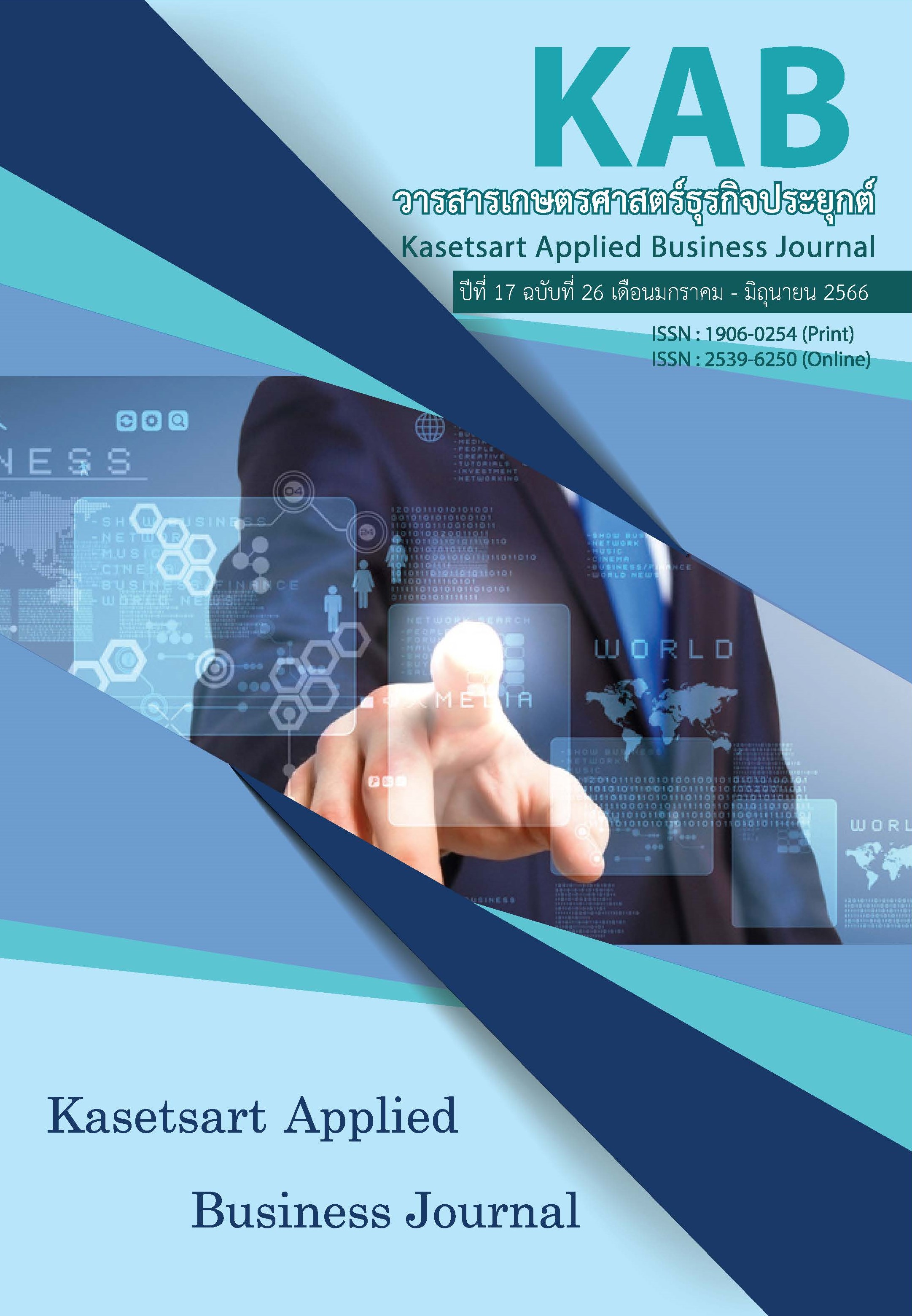การตอบสนองของราคาของหุ้นที่ถูกปรับเข้าและออกจากดัชนี SET 50 : หลักฐานเชิงประจักษ์ล่าสุด
Main Article Content
บทคัดย่อ
งานวิจัยนี้ศึกษาการตอบสนองของราคาของหุ้นที่ถูกปรับเข้าและออกจากดัชนี SET 50 ในช่วงปี ค.ศ. 2011 ถึงปี ค.ศ. 2021 และพบว่าหุ้นที่ปรับเข้า (ออกจาก) ดัชนี SET 50 เกิดผลตอบแทนผิดปกติที่ 0.87% (-0.93%) ในวันประกาศการปรับเข้า (ออกจาก) ดัชนี SET 50 และมีราคาที่ปรับขึ้น(ปรับลง)อย่างต่อเนื่องไปจนถึงวันที่มีผลจริง แต่เกิดการกลับตัวของราคาหลังจากวันที่มีผลจริง ผลการศึกษานี้จึงสอดคล้องกับสมมุติฐาน Price Pressure จากนั้น การศึกษานี้แยกกลุ่มตัวอย่างของหุ้นปรับเข้าออกจากดัชนีออกเป็น 2 ช่วงเวลา คือช่วง 6 ปีแรกหรือปี ค.ศ. 2011 ถึงปี ค.ศ. 2016 และช่วง 5 ปีหลังหรือปี ค.ศ. 2017 ถึงปี ค.ศ. 2021 และพบว่า ผลกระทบต่อราคาของหุ้นที่ถูกปรับเข้าและออกจากดัชนี SET 50 มีความรุนแรงขึ้นในช่วง 5 ปีหลังเมื่อเทียบกับช่วง 6 ปีแรก แต่ยังคงเกิดการกลับตัวของราคาอย่างเต็มที่ในระยะยาว เว้นแต่หุ้นปรับเข้าในช่วง 5 ปีหลังที่การกลับตัวของราคานั้นไม่เต็มที่ ผลการศึกษานี้น่าจะแสดงให้เห็นถึงข้อจำกัดการทำอาบิทราจจากผลกระทบต่อราคาของหุ้นที่ถูกปรับเข้าและออกจากดัชนี ที่เพิ่มสูงขึ้นในช่วงปี ค.ศ. 2017 ถึงปี ค.ศ. 2021 เมื่อเทียบกับในช่วงปี ค.ศ. 2011 ถึงปี ค.ศ. 2016
Article Details

อนุญาตภายใต้เงื่อนไข Creative Commons Attribution-NonCommercial-NoDerivatives 4.0 International License.
Journal of TCI is licensed under a Creative Commons Attribution-NonCommercial-NoDerivatives 4.0 International (CC BY-NC-ND 4.0) licence, unless otherwise stated. Please read our Policies page for more information...
เอกสารอ้างอิง
มรกต ชนินทรานุรักษ์, ณัฐวุฒิ เจนวิทยาโรจน์, และไทยศิริ เวทไว. (2554). ผลกระทบต่อราคาและปริมาณการซื้อขายของหลักทรัพย์ที่ถูกปรับเข้าและออกจากดัชนี SET50. จุฬาลงกรณ์ธุรกิจปริทัศน์, 33(129), 1-24.
Afego, P. N. (2017). Effects of changes in stock index compositions: A literature survey. International Review of Financial Analysis, 52, 228-239.
Biktimirov, E. N., & Xu, Y. (2019). Market reactions to changes in the Dow Jones industrial average index. International Journal of Managerial Finance, 15(5), 792–812.
Cai, J. (2007). What’s in the news? Information content of S&P 500 additions. Financial Management, 36(3), 113-124.
Chakrabarti, R., Huang, W., Jayaraman, N., & Lee, J. (2005). Price and volume effects of changes in MSCI indices-nature and causes. Journal of Banking & Finance, 29(5), 1237-1264.
Chan, K., Kot, H. W., & Tang, G. Y. N. (2013). A comprehensive long-term analysis of S&P 500 index additions and deletions. Journal of Banking and Finance, 37, 4920–4930.
Chen, H., Noronha, G., & Signal, V. (2004). The price response to the S&P 500 additions and deletions: evidence of asymmetry and a new explanation. Journal of Finance, 59, 1901–1929.
Cusick, P. A. (2002). Price effects of addition or deletion from the Standard & Poor’s 500 index: evidence of increasing market efficiency. Financial Markets, Institutions, and Instruments, 11(4), 349-383.
Erwin, G. R., & Miller, J. M. (1998). The liquidity effects associated with addition of a stock to the S&P 500 index: evidence from bid/ask spreads. Financial Review, 33(1), 131-146.
Harris, L., & Gurel, E. (1986). Price and volume effects associated with changes in the S&P 500 list: new evidence for the existence of price pressures. Journal of Finance, 41(4), 815–829.
Investment Company Institute. (2021). 2021 Investment company fact book: a review of trends and activities in the investment company industry.
Jain, P. (1987). The effect on stock price of inclusion or exclusion from the S&P 500. Financial Analysts Journal, 43(1), 58-65.
Jenwittayaroje, N. (2014). Index effects: a review and comments. Chulalongkorn Business Review, 36(140), 1–15.
Kappou, K. (2018). The diminished effect of index rebalances. Journal of Asset Management, 19(4), 235-244.
Li, B., & Qian, S. (2022). Market integration and asset prices: evidence from the inclusion of China A-shares in MSCI global indices, available at SSRN: https://ssrn.com/abstract=4074309
Li, K., Liu, X., & Wei, S. J. (2021). Is stock index membership for sale?. National Bureau of Economic Research, Working Paper 29365.
Lu, M. P., & Ahmad, Z. (2019). Impact of additions and deletions from stock index in Malaysia: the role of opinion divergence theory. International Journal of Business and Society, 20(2), 709-729.
Lynch, A., & Mendenhall, R. (1997). New evidence on stock price effects associated with changes in the S&P 500 index. Journal of Business, 70(3), 351–383.
Mase, B. (2007). The impact of changes in the FTSE 100 index. Financial Review, 42(3), 461-484.
Okada, K., Isagawa, N., & Fujiwara, K., (2006). Addition to the Nikkei 225 Index and Japanese market response: Temporary demand effect of index arbitrageurs. Pacific-Basin Finance Journal, 14(4), 395-409.
Papachristou, G., Papadamou, S., & Spyromitros, E. (2018). Asymmetric price responses to stock addition to and deletion from the Athens Stock Exchange index. Managerial Finance, 44(4), 406-423.
Patel, N., & Welch, I. (2017). Extended stock returns in response to S&P 500 index changes. Review of Asset Pricing Studies, 7(2), 172-208.
Preston, H., & Soe, A. M. (2021). What happened to the index effect? a look at three decades of S&P 500 adds and drops. S&P Dow Jones Indices, September 2021.
Shleifer, A. (1986). Do Demand Curves for Stocks Slope Down?. Journal of Finance, 41(3), 579–590.
Sun, Y. (2021). Index fund entry and financial product market competition. Management Science, 67(1), 500-523.
Wang, C., Murgulov, Z., & Haman, J. (2015). Impact of changes in the CSI 300 index constituents. Emerging Markets Review, 24, 13-33.
Wurgler, J., & Zhuravskaya, E. (2002). Does arbitrage flatten demand curves for stocks?. Journal of Business, 75(4), 583-608.


